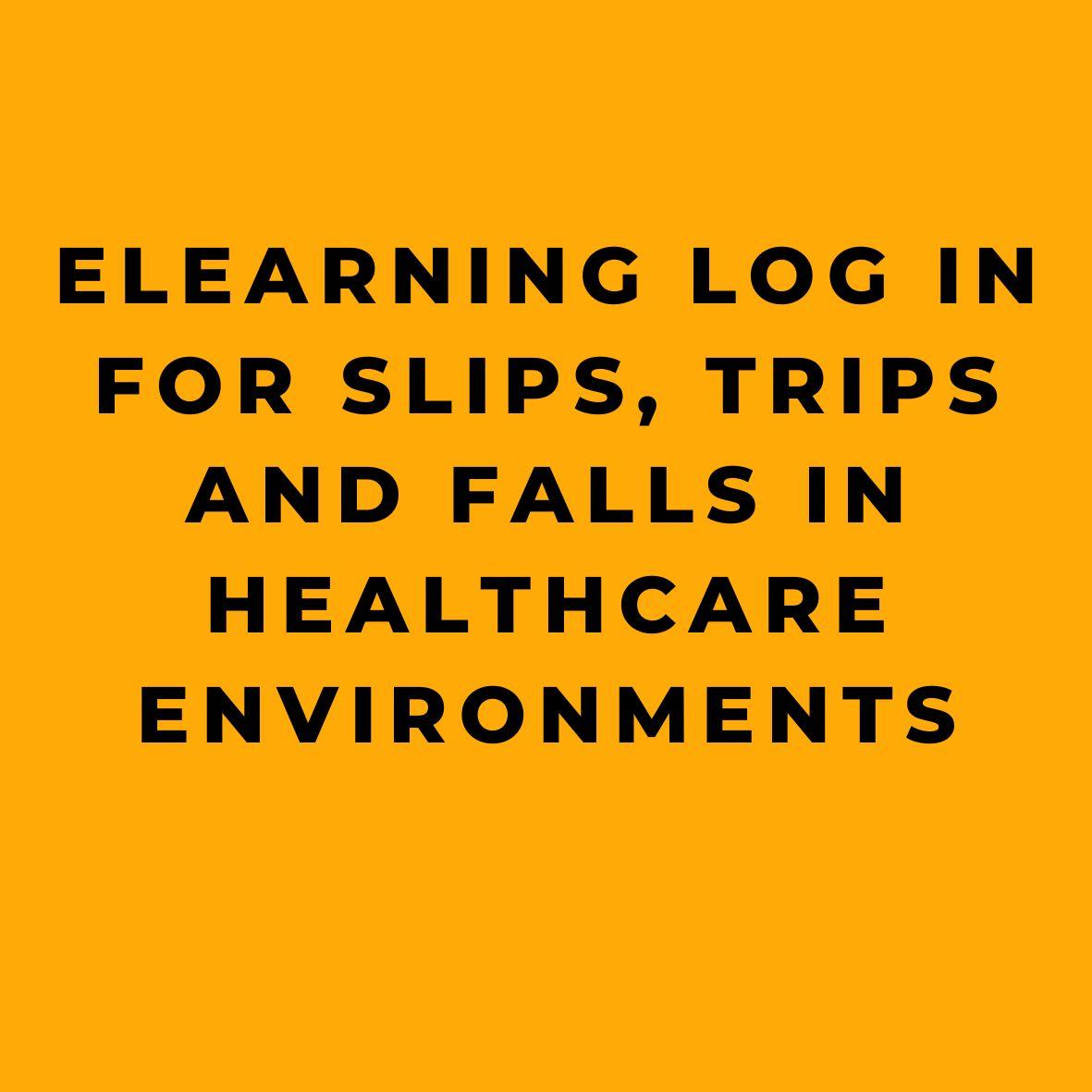eLearning Log In for Slips, Trips and Falls in Healthcare Environments
Slips, trips, and falls in healthcare environments is a serious issue that affects not only healthcare workers, but also patients and visitors. In this article, we’ll go through the major program points that will help you understand the hazards that lead to slips, trips, and falls, and how to avoid them.
Let’s start by understanding how our bodies are able to stand and walk upright in the first place. It all comes down to our center of gravity, which is the point where the weight of the body is equally distributed, half above and half below. This plays an important part in every movement we make. To find your center of gravity, imagine that you’re standing up straight, with your feet forming the two points at the “base”. The third point of the triangle is at your lower back, and the “upper point” of the triangle is located roughly where your center of gravity would be. As you move, these three points are constantly changing positions. If your center of gravity extends out past your feet, you could lose your balance and fall.
Now, because the shape and size of our bodies have a direct impact on how naturally stable we are, it’s easier for some people to keep their balance than others. For example, a short person will have a lower center of gravity and be more stable than a tall person. How you stand also affects your stability. You are in your most stable standing position when you are perfectly upright, with your arms at your sides. This keeps your center of gravity low and over your feet. If you are slouching or hunching your shoulders, your center of gravity can extend out past your feet, making you less stable. Reaching forward or sideways for something can have the same effect. When you reach over your head, you raise your center of gravity, which also reduces your stability. The weight of anything that you’re holding makes you even more unstable.
Walking can be a risky activity, as it requires us to fall and catch ourselves with every step. While we’re doing that, there is a lot of opportunity for us to slip or trip along the way. Momentum is the force that we build up as we move in any direction. It tends to keep our body and its center of gravity going in the same direction. But if we encounter something that interferes with our progress, such as an object or slick surface, it can cause trouble. Trips generally occur when our foot or lower leg catches on something. This causes our lower body to stop while our momentum keeps our center of gravity moving, so that we lose our balance. Stepping onto a lower level, such as when we’re going downstairs, can also cause us to trip, especially if the surface is uneven or damaged. Slipping occurs when something interferes with the amount of friction between our shoes and the surface we’re walking on. When this happens, it can cause our feet to move out from under our center of gravity while our momentum keeps us moving, causing us to lose our balance, which, like tripping, can also result in a fall.
It’s important to remember that our momentum increases when we walk faster and when we carry more weight, things that we’re very likely to be doing when we’re on the job. So the faster we go and the more that we carry, the more attention we need to pay to potential slip and trip accidents. In addition to slips and trips, you need to watch out for fall hazards during a busy workday as well. If you don’t, it can lead to pain, injuries, or even worse.
If you need to reach something up high, you should use a ladder. Be sure to keep your center of gravity positioned between the two upright rails. Using a ladder can be dangerous if not used properly. Therefore, it’s crucial to follow safety procedures when climbing a ladder. One of the essential rules is to maintain three points of contact with the ladder at all times. This can be achieved by either having both feet and one hand on the ladder or both hands and one foot on the ladder.
Moreover, when using a ladder, make sure it’s placed on a stable surface and secured. If the surface is uneven, use ladder levelers to prevent the ladder from tipping over. Also, avoid leaning too far out when on a ladder, as it can cause the ladder to shift, leading to a fall.
It’s not only the use of ladders that can lead to falls in the workplace. Any raised platform, such as stairs or elevated workstations, can be hazardous if not used correctly. To minimize the risk of falls, it’s essential to ensure that all stairways and elevated platforms are correctly maintained, with no obstructions, tears or cracks.
Workers who need to access elevated workstations should use sturdy platforms or scaffolding. These platforms should be regularly inspected to ensure their safety and stability. Additionally, workers should wear personal protective equipment (PPE), such as safety harnesses, to prevent falls from heights.
To avoid slips, trips, and falls, the workplace should be kept clean and tidy. Employers should ensure that all walkways are clear of debris, spills, or obstacles. They should also ensure that all floors are dry and that spills are promptly cleaned up to prevent slips.
Regular housekeeping should be conducted, and cleaning equipment, such as mops and brooms, should be stored correctly after use. Furthermore, employers should provide appropriate footwear to their employees, depending on the job’s nature and the floor surfaces.
Slips, trips, and falls are common hazards that can cause serious injuries and even fatalities in the workplace. However, the risk of these hazards can be minimized by following appropriate safety procedures, maintaining a clean and tidy workplace, and wearing appropriate footwear. By taking these precautions, workers can stay safe and avoid the consequences of slips, trips, and falls.
Our online interactive courses are designed to keep employees engaged and involved in the learning process. The courses are constructed in such a way that employees have to pay attention in order to keep moving through them. The use of full-motion HD video filmed in real-life workplace settings and interactive quiz questions ensures that employees are fully engaged in the learning process and retain more of the information they have learned.
One of the best features of our online courses is that it incorporates remediation training. If a trainee misses a question on a quiz while the trainee is taking the course, the trainee is presented with the course content that explains the topic over again. This means that training time is reduced and the courses are much more efficient and effective.
It’s important to note that training activity is tracked and recorded along with test scores, making it easy for managers to monitor their employees’ progress.
We offer a range of different types of online safety courses, including adaptive learning courses, micro-learning courses, full-length interactive courses, and video streaming (VOD) courses. Our libraries contain over 170 courses on important topics such as regulatory compliance, human resource topics, and general safety topics. Some of the topics covered include forklift/powered industrial truck safety, lock-out/tag-out, hazard communication, personal protective equipment, respiratory safety, confined space entry, and hearing safety.
Looking to ensure your workplace is safe and hazard-free? Look no further than this comprehensive course on “Slips, Trips and Falls in Healthcare Environments”. Our course covers everything you need to know about identifying and preventing hazards that cause slips, trips, and falls, both at work and at home.
With topics ranging from the importance of your center of gravity to the proper footwear to prevent slips and falls, our course is designed to keep your employees engaged and involved in the learning process. Our full-motion HD videos filmed in real-life workplace settings and interactive quiz questions ensure that your employees retain the information they have learned.
One of the best features of our online courses is remediation training. If an employee misses a question on a quiz, they are presented with the course content that explains the topic again. This means that training time is reduced, and courses are more efficient and effective.
Our library of courses contains over 170 courses on important topics such as regulatory compliance, human resource topics, and general safety topics. Our courses are available in a range of different types, including adaptive learning courses, micro-learning courses, full-length interactive courses, and video streaming (VOD) courses.
Don’t wait until an accident occurs to take action. Invest in “Slips, Trips and Falls in Healthcare Environments” course today and ensure that your workplace is safe and hazard-free.


